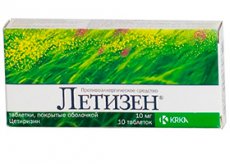Medical expert of the article
New publications
Preparations
Letizen
Last reviewed: 04.07.2025

All iLive content is medically reviewed or fact checked to ensure as much factual accuracy as possible.
We have strict sourcing guidelines and only link to reputable media sites, academic research institutions and, whenever possible, medically peer reviewed studies. Note that the numbers in parentheses ([1], [2], etc.) are clickable links to these studies.
If you feel that any of our content is inaccurate, out-of-date, or otherwise questionable, please select it and press Ctrl + Enter.

Letizen helps to get rid of allergic symptoms, as well as itching; in addition, the drug has an anti-exudative effect.
The active component of the therapeutic agent, cetirizine, helps to strengthen the strength of blood vessels, thereby eliminating smooth muscle spasms and preventing the occurrence of edema. The use of the drug in people with mild forms of bronchial asthma helps to reduce the bronchoconstriction associated with the influence of histamine.
Indications Letizena
It is used as a treatment for permanent or seasonal conjunctivitis or rhinitis caused by the influence of allergens.
It is also prescribed in cases of urticaria, Quincke's edema, hay fever and itchy dermatoses (of allergic origin).
Release form
The medicinal product is released in the form of tablets and oral solution.
The tablets have a volume of 10 mg and are contained in 10 pieces inside a blister pack. There are 1 or 2 such packs in a box.
The solution is contained in 0.12 l bottles. Inside the pack there is 1 bottle with the solution and a dosing syringe.
Pharmacodynamics
The antihistamine effect of the drug develops when the activity of peripheral endings of histamine H1 is blocked by cetirizine. The drug demonstrates the greatest effectiveness in the early stages of allergy; it weakens the release of mediators of later stages of the allergic process.
The drug relieves epidermal symptoms that arise under the influence of cold allergy, specific allergens, and also in the case of the introduction of histamine.
Dosing and administration
The medication in both forms should be taken at the same time of day (it is recommended to do this in the evening), with plain water. A portion of the solution is drawn up through a dosing syringe included in the pack with the medication.
For a teenager over 12 years old and an adult, 1 tablet (volume 10 mg) is required, which is taken once a day. A child aged 6-12 years is prescribed 0.5 tablets (5 mg), once a day.
The solution is prescribed to adolescents aged 12 years and older and adults in a 10 mg portion once a day (equivalent to 10 ml – 2 dosing syringes). Infants aged 1-2 years are given 2.5 ml of the substance twice a day. At the same time, children aged 2-6 years are given 5 ml of the drug once a day (or 2.5 ml of liquid twice a day), and children aged 6-12 years are given 5 ml of the substance twice a day.
In case of moderate renal dysfunction, it is necessary to take 5 mg of the medicine once a day; if the degree of impairment is severe, it is necessary to administer 5 mg of the medicine once every 48 hours.
The duration of the treatment cycle is determined by the severity of the allergic disorder and is selected individually by the attending physician.
Contraindications
Main contraindications:
- the presence of intolerance associated with elements of the therapeutic agent;
- hypolactasia;
- terminal phase of renal failure;
- intolerance associated with fructose or lactose.
Caution is required when administering the drug to patients with chronic renal failure, liver pathologies, and when prescribing it to elderly people.
Side effects Letizena
Often, the use of drugs causes a runny nose, dry mouth, pharyngitis, headaches, and in addition, systemic weakness, nausea, dizziness and thrombocytopenia.
Occasionally, the introduction of Letizen leads to drowsiness, agitation, migraine, insomnia and confusion. In addition, taste disorders, abdominal pain, paresthesia and problems with liver function occur. Tremor, tachycardia, convulsions, fainting, hallucinations, aggression, dyskinesia, dystonia, confusion and nystagmus also occur. Weight gain, tics, enuresis, asthenia, urinary disorders, visual or accommodation disorders, and swelling of the legs are noted.
Taking the medication may provoke allergy symptoms (rash, Quincke's edema, itching, anaphylaxis and urticaria).
Overdose
In case of poisoning with Letizen, lethargy, stupor, dizziness, anxiety and confusion are observed, as well as tachycardia, diarrhea, mydriasis, headaches, tremors, general malaise, confusion and urinary retention.
Interactions with other drugs
Metabolic processes and drug excretion are slowed down when using theophylline.
When combining drugs and myelotoxic substances, the risk of developing severe side effects increases.
 [ 6 ]
[ 6 ]
Storage conditions
Shelf life
Letizen can be used for a period of 5 years from the date of sale of the pharmaceutical element.
Application for children
Tablets of the drug are not prescribed in pediatrics for children under 6 years of age, and the solution is not prescribed to infants under 12 months of age.
Analogues
The analogs of the drug are Rolinoz, Maxidex, Oktilia and Hydrocortisone with Cortef and Clarisens. In addition, the list includes Solu-medrol, Zaditen, Visoptic and Medrol, Polinadim, Loraghexal and Defislez, as well as Clarotadine, Prenacid, Zirtek with Cetirinax and Claridol.
 [ 10 ]
[ 10 ]
Attention!
To simplify the perception of information, this instruction for use of the drug "Letizen" translated and presented in a special form on the basis of the official instructions for medical use of the drug. Before use read the annotation that came directly to medicines.
Description provided for informational purposes and is not a guide to self-healing. The need for this drug, the purpose of the treatment regimen, methods and dose of the drug is determined solely by the attending physician. Self-medication is dangerous for your health.

